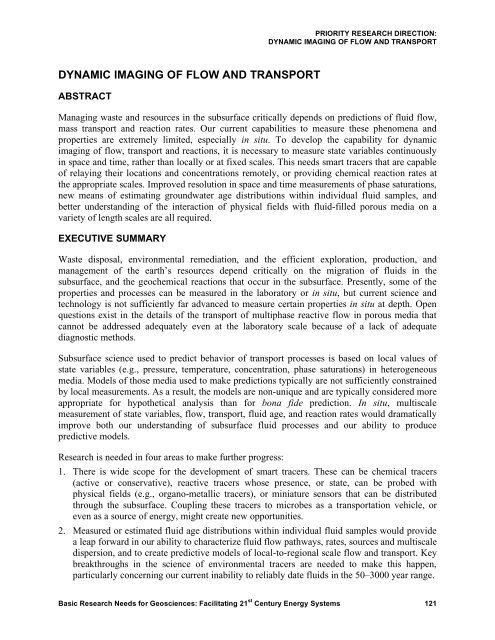Basic Research Needs for Geosciences - Energetics Meetings and ...
Basic Research Needs for Geosciences - Energetics Meetings and ...
Basic Research Needs for Geosciences - Energetics Meetings and ...
- No tags were found...
Create successful ePaper yourself
Turn your PDF publications into a flip-book with our unique Google optimized e-Paper software.
PRIORITY RESEARCH DIRECTION:DYNAMIC IMAGING OF FLOW AND TRANSPORTDYNAMIC IMAGING OF FLOW AND TRANSPORTABSTRACTManaging waste <strong>and</strong> resources in the subsurface critically depends on predictions of fluid flow,mass transport <strong>and</strong> reaction rates. Our current capabilities to measure these phenomena <strong>and</strong>properties are extremely limited, especially in situ. To develop the capability <strong>for</strong> dynamicimaging of flow, transport <strong>and</strong> reactions, it is necessary to measure state variables continuouslyin space <strong>and</strong> time, rather than locally or at fixed scales. This needs smart tracers that are capableof relaying their locations <strong>and</strong> concentrations remotely, or providing chemical reaction rates atthe appropriate scales. Improved resolution in space <strong>and</strong> time measurements of phase saturations,new means of estimating groundwater age distributions within individual fluid samples, <strong>and</strong>better underst<strong>and</strong>ing of the interaction of physical fields with fluid-filled porous media on avariety of length scales are all required.EXECUTIVE SUMMARYWaste disposal, environmental remediation, <strong>and</strong> the efficient exploration, production, <strong>and</strong>management of the earth’s resources depend critically on the migration of fluids in thesubsurface, <strong>and</strong> the geochemical reactions that occur in the subsurface. Presently, some of theproperties <strong>and</strong> processes can be measured in the laboratory or in situ, but current science <strong>and</strong>technology is not sufficiently far advanced to measure certain properties in situ at depth. Openquestions exist in the details of the transport of multiphase reactive flow in porous media thatcannot be addressed adequately even at the laboratory scale because of a lack of adequatediagnostic methods.Subsurface science used to predict behavior of transport processes is based on local values ofstate variables (e.g., pressure, temperature, concentration, phase saturations) in heterogeneousmedia. Models of those media used to make predictions typically are not sufficiently constrainedby local measurements. As a result, the models are non-unique <strong>and</strong> are typically considered moreappropriate <strong>for</strong> hypothetical analysis than <strong>for</strong> bona fide prediction. In situ, multiscalemeasurement of state variables, flow, transport, fluid age, <strong>and</strong> reaction rates would dramaticallyimprove both our underst<strong>and</strong>ing of subsurface fluid processes <strong>and</strong> our ability to producepredictive models.<strong>Research</strong> is needed in four areas to make further progress:1. There is wide scope <strong>for</strong> the development of smart tracers. These can be chemical tracers(active or conservative), reactive tracers whose presence, or state, can be probed withphysical fields (e.g., organo-metallic tracers), or miniature sensors that can be distributedthrough the subsurface. Coupling these tracers to microbes as a transportation vehicle, oreven as a source of energy, might create new opportunities.2. Measured or estimated fluid age distributions within individual fluid samples would providea leap <strong>for</strong>ward in our ability to characterize fluid flow pathways, rates, sources <strong>and</strong> multiscaledispersion, <strong>and</strong> to create predictive models of local-to-regional scale flow <strong>and</strong> transport. Keybreakthroughs in the science of environmental tracers are needed to make this happen,particularly concerning our current inability to reliably date fluids in the 50–3000 year range.<strong>Basic</strong> <strong>Research</strong> <strong>Needs</strong> <strong>for</strong> <strong>Geosciences</strong>: Facilitating 21 st Century Energy Systems 121
















